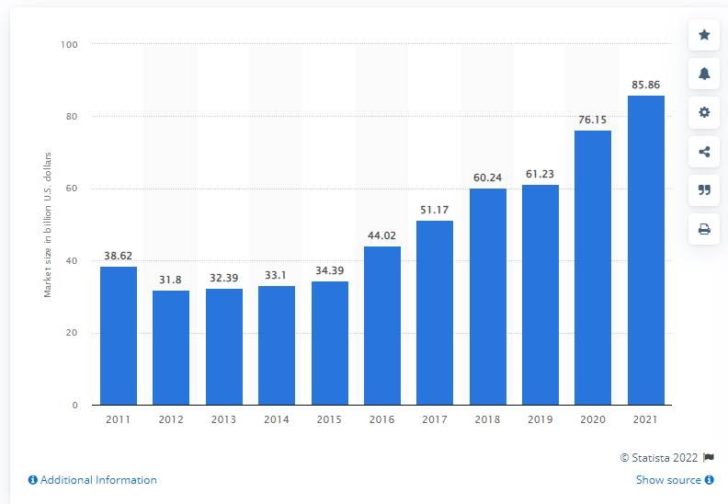30-second summary:
- As the world starts to return to normalcy, the gaming and live streaming industry need SEO, social networking, and online marketing for continued growth
- I spoke with industry influencers Alinity, Matt Rehwoldt, and eUnited’s General Manager and VP, Matt Potthoff on the industry’s current scenario, the obstacle course for amplified audience engagement, and the budding need for innovation
Over the past five years, the boom of the live-streaming, esports, and gaming industries has been stealing headlines not only in the tech industry but also in mainstream media.
That boom only increased its radius during the pandemic, which saw astronomical highs in terms of viewership numbers for the Amazon-owned Twitch streaming platform, Google’s YouTube, and even Facebook Gaming, who jumped more aggressively into the marketplace with the acquisition of Microsoft’s Mixer platform during the summer of 2020.
Since then, much of the world has started getting back to more normalcy, which means that studios are back to work on big project games, esports teams are heading back to regular competitions, and the streaming landscape continues its evolution.
Despite the boom, the industry lacks some key ingredients
But despite the impressive numbers, the industry as a whole still lacks some key ingredients that can not only take the industry to the next level, but also improve the business landscape of content creators as well.
More often than not, the industry is splintered off into a number of sectors that, aside from annual conventions and events, don’t often regularly network efficiently.
Compounding the limitations of networking efficiency is the void in marketing practices such as search engine optimization (SEO) and traditional internet marketing that content creators and brands are leaving on the table.
Some of the core complaints among streamers and content creators, among others, is – the lack of discoverability provided by their platforms, and how their growth seems bottlenecked and capped due to the lack of visibility.
Furthermore, content creators and brands often find themselves in the cycle of social media posting, which can lean heavily into monotony and automation – two major factors that drive down engagement.
Sure, you can blame the platforms themselves and you would be partially right. Social media platforms are a wide net of interests and demos, so posts may not hit at high percentages consistently. Streaming platforms seem to be staying the course, which is smart business as it has proven to be profitable, even during the most challenging economic crisis in nearly a century.
That leaves content creators, esports teams, game studios, and the industry as a whole, at a crossroads. Where innovation has seemed to bypass the needs for more connected networking and growth potential, many are forced to double down on the work despite the lack of return just to stay afloat.
Natalia Mogollon, better known as Alinity, is one of the most popular streamers on the Twitch platform, boasting over one million followers to her channel and had leveraged the platform to build one of the more recognizable brands in the streaming industry.
Streaming and content creators
To get an objective perspective on the matter, I caught up with gaming content creator, Alinity and Matt Rehwoldt, former WWE wrestler and content creator.

“In regards to networking with other creators, I feel like most creators currently use Twitter for that”
“The problem is that I don’t know which creators are genuinely interested in networking and which just want interactions in order to increase their following. It’s probably 50-50.
“But again, I think the market for small to medium size creators is huge. People that are starting to grow and want to meet other creators”
And it’s the market that remains largely untapped or maximized.
Outside of the most famous streamers in the world, many streamers may be stuck under a ceiling or bottlenecked when it comes to growth, and that is where the streaming side of the industry needs to evolve.
A few years ago, professional wrestler and content creator Matt Rehwoldt was involved in the WrestleMania 34 United States Championship match between Randy Orton, Bobby Roode, Jinder Mahalm, and Rusev, performing in front of over 78,000 people in New Orleans, Lousiana.
And while Rehwoldt is back in the industry with promotions such as New Japan Pro Wrestling and rumored to be heading to Impact Wrestling, the ‘Drama King’ has carved out a home for his brand on both Twitch and YouTube.
Despite his name recognition and work on some of the biggest wrestling stages in the industry, the limitations that platforms present can still negatively impact his content.

“The biggest challenge facing content creators is always discoverability,”
“Twitch struggles with this the most and it’s been said to death by any “How To Grow On Twitch” video you see on YouTube – which is the very point. You need to bring people to Twitch from other sources as their search and discoverability is extremely limited.”
“Here I’ll refer your readers to Alpha Gaming’s Harris Heller. He makes some great points about Twitch’s weaknesses with the most glaring being its searchability.
The inclusion of things like highlights or clips is very cool, but why can’t I search “Crazy FRAG” and find a whole list of clips around those search terms? Then through watching things like that I find new creators. So there needs to be more searchable content on Twitch where you don’t have to just go to the search bar and type the exact name of the stream you’re looking for.”
“Browsability is key,” he said.
But Rehwoldt also points out that YouTube may present better discoverability but also has its own setbacks.
“YouTube is better but there you’re competing in an even larger ecosystem against clickbait warriors and what feels like the whole world”
he points out.
Rehwoldt goes on to point out how SEO is not only impactful but a valuable resource to learn and utilize.
“That said, if you can take the time to teach yourself a little SEO and how to use titles and keywords properly, it’ll help you a lot. It’s something I still struggle with and am learning too.”
But like many streamers, Rehwoldt has been frustrated with the issues that hold back his content. He stresses the importance of understanding that it all comes down to patience and hard work.
“I’m still learning,”
Rehwoldt says.
“My channels are growing but not nearly as fast as I’d like them to. So for me, it’s more about keeping my mind right. Do good work that I love and the growth seems to come. Not letting myself get discouraged because some video or stream didn’t “pop off” is key too.”
“Everyone points to people like Ludwig or other creators who blew up seemingly overnight and then get frustrated when they feel like they make similar quality content and the same doesn’t happen to them.”
Well there are two things to consider here: First, that often those creators didn’t blow up from “nowhere” and they’ve been working hard either behind the scenes or prior to launching their content and got seen by the right people at the right time. A classic case of preparation meets opportunity.
Secondly, life is also full of incredible exceptions.
People who explode into stardom because they went viral etc. But never ever try to compare yourself to the exception. I’ve known and spoken to so many creators, those who make a living at it, and it takes years of trying and putting out content that you later look back on and shake your head. Trial and error everyone. Have patience with your work and yourself.”
Esports
While SEO is not prominent in sectors such as streaming, and the collective industry as a whole, it has trickled in with regards to the Esports industry.
Matt Potthoff is the general manager and Vice President of eUnited, and a former professional esports player who has won championships as a player, coach, and general manager.

“eUnited has blossomed into a staple esports organization in North America since its inception in 2016”, Potthoff said.
“We have competed across many titles and have accumulated over $3 million dollars in prize winnings.
eUnited’s most notable championships are winning the 2018 Smite World Championship and the 2019 Call of Duty World Championship. We pride ourselves on growing amateur talent into championship contender players over numerous gaming communities.”
Part of their growth has been the incorporation of SEO and internet marketing through leveraging social media.
“eUnited does use elements such as SEO to increase visibility when selling merchandise or showcasing new sponsors. Additionally, we help players revise their stream titles and descriptions for better chances of obtaining new viewership when users are searching for different topics on Twitch”
Potthoff points out that the integration of internet marketing, SEO, and targeted social networking can provide results and those results can impact profitability.
“eUnited leverages streaming platforms to grow their players’ brands and sell ads to sponsors by utilizing their player’s streaming audience. Most sponsorship activations in esports that aren’t held in person are done over streaming platforms like Twitch”
Innovation and moving forward with solutions
Regardless of the sector of industry, it seems the problems remain the same, and some success can be rooted in the implementation of SEO and optimized networking.
- But how does the industry innovate to address this?
- How do content creators address the areas of need?
- How do we implement better networking and more meaningful connectivity between these different sectors?
Many brands and content creators face hurdles with finding these solutions. They may not have the budget to consistently contract a quality Internet Marketing & SEO agency, and the SEO agency market certainly doesn’t hone in on these offerings.
So, what is the solution?
I considered all of this when I initially launched Gamactica in October 2018. I asked myself these same questions, and I saw the very issues pointed out in this article when I started streaming.
This is why the foundation of what we have been building with Gamactica is rooted in SEO, internet marketing, and intuitive social networking for the industry. Award-winning internet marketing company Elite Rank Media is the backbone of the internet marketing initiatives and processes. Since 2009, the company has been providing marketing services to brands around the world and has been recognized for its work in both Medical SEO and localized Miami SEO marketing, among others.
An industry where content creators, streamers, gamers, esports teams, esports players, game studios and developers, and cosplayers are spread out so distantly on the social space is one that needs the innovation of improved connectivity.
Our purpose is to provide a professional social network to streamline social networking, bring these sectors together more efficiently, and provides the tools and resources that empower these brands and content creators to reach new levels.
And these are the innovations that can help push through the ceilings, break through the bottlenecks, and clear the hurdles that everyone seems to face, regardless of the industry sector.
Gamactica is implementing those innovations.
“I think the idea is very interesting,”
Alinity says of Gamactica.
“Most current social media platforms focus on relationships with our followings, but a new focus towards networking is innovative. It almost makes me think of LinkedIn.
“I feel like it has a lot of potential for connecting brands and creators, I think there is a big need in that regard. It seems like some streamers are really well connected and get lots of sponsorships, whereas the new creators have no idea how to get these. I think there is a big untapped market within the creators with about 100-500 concurrents (viewers)”
she adds.
“They have more tight communities and often get overlooked but I think there is a huge potential for brand deals with high return on investment for brands, as they tend to be more connected with their viewers. This connection becomes difficult once you get over 1000 concurrent viewers”
she continued.
Alinity points out the vitality of the current market size, the need for better networking, and industry innovation.
“I think the market for small to medium size creators is huge. People that are starting to grow and want to meet other creators. I think the large “whale” streamers would be a good influence for smaller ones to join.”
During the journey of Gamactica, it has been key to stand out as a unique platform, and showcasing how it stands alone is vital to the continued growth.
“I love the idea of something like Gamatica”,
Rehwoldt said.
“But I will be blunt – I’ve seen many trying to compete in this niche space as well. I myself have been approached by several ‘gamer social media’ sites where you open an account, you can link all your streams, socials etc, and it involves you in a like-minded community with the idea that you can all discover each other.
“The key here will be offering something to truly stand apart! Think outside the box!”
And that outside the box thinking is structured in Gamactica’s platform, community, and directories. Streamlining popular social networking features and intuitively interweaving them with the marketing and branding impact that is needed on a larger scale.
“I do think a platform that offers a solution to increase visibility for players is needed,”
Potthoff said.
“My only problem is that a majority of the users are on platforms such as Discord, Twitch, and YouTube.”
“I feel anyone can be discovered in gaming,”
he added.
“It just takes the right moment and presence to take advantage of a situation. If another platform is increasing the odds for a player or company to be discovered, they should definitely sign up and take advantage of it.”
Pushing the needed innovations is at the core of Gamactica’s journey, and implementing the proper concepts while listening to the industry, as a whole, will shape its continued growth.
Not only is the focus on connectivity and marketing, but also helping structure the platform to help combat the harassment and toxicity issues that plague the industry, and also help empower female creators and brands that are operating in a male-dominated sector.
The future requires innovation to achieve growth and continued success, and that journey is what Gamactica is dedicated to continuing.
Stay tuned for more articles in this series.
Anthony DiMoro is CEO of Gamactica. He can be found on Twitter @AnthonyDiMoro.
Subscribe to the Search Engine Watch newsletter for insights on SEO, the search landscape, search marketing, digital marketing, leadership, podcasts, and more.
Join the conversation with us on LinkedIn and Twitter.
https://www.searchenginewatch.com/2021/08/02/the-future-of-gaming-and-streaming-a-networking-and-seo-arsenal/






